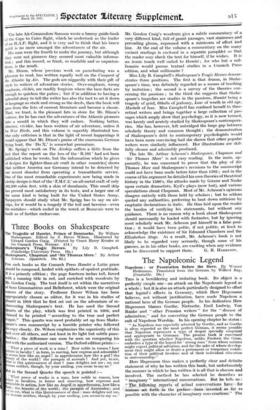Three Books on Shakespeare
Shakespeare's Tragic Heroes. By Lily B. Campbell.
(Cambridge University Press. 16s.) -
Shakespeare, Chapman and Sir Thomas More.' By Arthur • Acheson. (Que.ritch. 10s. 6d.)
Fon such books as the Cranach Press Hamlet a Latin grace should be composed, larded with epithets of opulent gratitude. It is a princely edition ; the page fourteen inches tall, fareed with a running title in red, and enriched with woodcuts by Mr. Gordon Craig. The text itself is set within the narratives of Saxo Granunaticus and Belleforest, which were the original sources of the story. Professor Dover Wilson has -been appropriately chosen as editor, for it was in his studies of liandef in 1918 that he first set out on the adventure of re- discovering Shakespeare's text. He has used the Second Quarto of the play, which was first printed in 1604, and claimed to be printed "according to the true and perfect Coppie." This quarto was most probably set up from Shake- Peace's own manuscript by a humble printer who followed S copy closely. Dr. Wilson emphasizes the superiority of this ext over all others, and not least in its light but subtle punc- nation ; the difference- can soon -be •seen on comparing his ext with the authorized version. The Oxford edition prints :- What a piece of work is 's manl How noble in reason how [tante in faculty I in form, in moving, how express and. admirable! action how like ,an angel! in apprehension how like a god! the uty of the world ! the paragon of. animals ! And yet, to me, hat is this quintessence of dust ? man delights not me ; no, nor °man neither, though, by your smiling, you seem to say so."'
lit in the Second Quarto the speech is pointed What peace of worke is a man, how noble in reason, how • t in faculties, in forme and mooving, how expresse and
cable in action, how like an Angell. in apprehension, how like a .- the. beautie..of the world; the paragon of Annimales; .and et to me, what is this Quintessence of dust : man delights not me, or woman neither, though by your smiling, you seeme to say so." Mr. Gordon Craig's woodcuts give a subtle commentary of a ;very different kind, full of gaunt passages, vast staircases and pervading 'gloom, expressed with a minimum of effort- find line. At the end of the volume a commentary on the many variant readings is enclosed in a separate pamphlet so that the reader may check the text for himself, if he wishes. It is an ironic touch well suited to hamlet; for who but a mil- lionaire would pursue textual studies in a- Cranach Press edition, and what millionaire ?
Miss Lily B. Campbell's Shakespeare's Tragic Heroes demon- strates three positions. The first is that drama, in Shake- speare's time, was definitely regarded as a means of teaching by imitation ; the second is a survey of the theories con- cerning the passions ; in the third she suggests that Shake- speare's tragedies are studies in the passions, Hamlet being a tragedy of grief, Othello of jealousy, Lear of wrath in old age, Macbeth of fear. Miss Campbell has confined herself to theo- retical writers and brings together a large collection of pas- sages which amply show that psychology, as it is now termed, was keenly and acutely studied by Shakespeare's contempora- ries. She has, however, left unbridged the large gap between scholarly theory and common thought ; the demonstration of Shakespeare's debt to contemporary psychologists would have been more convincing had she shown that other popular writers were similarly influenced. Her illustrations are skil- fully chosen and admirably produced: The late Mr. Arthur Acheson's Shakespeare, Chapman and Sir Thomas More' is not easy reading. In the main, ap- parently, he was concerned to prove that the play of Sir Thomas More and Shakespeare's revisions to the manuscript could not have been made before later than 1592; and in the course of his argument he detailed his own theories of theatrical history in the 1580's, the attacks made by Greene and Nashe upon certain dramatists, Kyd's plays (now lost), and various speculations about Chapman. Most of Mr. Acheson's opinions disagree entirely with those held by scholars ; but he seldom quoted any authorities, preferring to beat down criticism by emphatic declarations in italic. He thus laid upon the reader the burden of verifying his statements, but without any guidance. There is no reason why a book about Shakespeare should necessarily be loaded with footnotes, but by ignoring most scholarly work Mr. Acheson put himself in a false posi- tion; it would have been polite, if not politic, at least to acknowledge the existence of Sir Edmund Chambers and the Elizabethan Stage. As a result, Mr. Acheson's book is not likely to be regarded very seriously, though some of his guesses, as in his other books, are exciting when any evidence
can be discovered to support them. G. B. HARRISON.














































 Previous page
Previous page